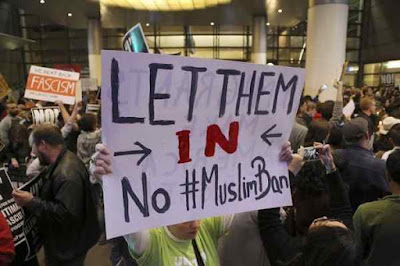Hello Everyone:
Before we get started on today's topic-the opioid epidemic-Blogger would like to send a big hello to all of the people fleeing the countries named in that ill-conceived executive order, hoping to enter the United States. To the families and friends of the detainees: please make sure you find a good lawyer to advise you. To the protestors: love will triumph in the end. To former Acting Attorney General Sally Yates: you are a hero. Shall we get started on opioid addiction and infrastructure?
 |
| Abandoned house Wilson Ring/AP citylab.com |
 |
| Housing Ast. Council on Twitter twitter.comE |
CityLab spoke with Alan Morgan, the director of the National Rural Health Associate, about why housing infrastructure is important in the battle against the opioid epidemic. Below are excerpts from the interview.
 |
| Man walking down the dark path of addiction drugabuse.com |
AM: The opioid crisis has impacted the whole country, but Secretary Vilsack and even former President Bill Clinton have acknowledged that this is uniquely a rural issue...it's a growing problem.
It's not just in the emergency rooms-you really see the effect in the life expectancy data. From 1990 onwards, the life-expectancy rate has risen in urban areas, but there's actually been a decline among rural populations (for more information, please go to http://www.countyhealthrankings.org)...This for a number of reasons: smoking, cardiovascular disease, and cancer...,but overdose deaths and suicides are a big part of the problem, which is unusual, because these behavioral health issues...
 |
| Opioid crisis infographic mlc.org |
AM: When you look at the prevalence of behavioral health specialists and mental health specialists, there's a clinical shortage when it comes to these types of professionals in rural areas. So you've got a self-perpetuating systems where the most in need of health care services have the fewest options available...
In urban, you've got treatment centers, you've got behavioral health professionals. You have drug-recovery programs and protocols. In rural communities, you might not have that safety net available, but health care options are built around prescription opioids...without good follow-up treatment...And often, this is a transportation issue-the nearest health care facilities can sometimes be hours aways, and when sustained treatment and follow-up is inaccessible, addiction takes the place.
 |
| A typical opioid salon.com |
AM: We have an unfortunate tendency to silo our sectors. When it comes to the opioid epidemic, we can no longer afford to do that. It's a health issue, but there's a transit component, and there is certainly a housing component. People need to be in a stable, drug-free environment to complete the recovery process...in rural areas, there's a real shortage of affordable housing that is safe and drug-free. If people get into treatment then are released back into the same housing situations where they have access to opioids, then it just exacerbates the issue.
So what often happens is that people struggling with addiction fall into homelessness: Around 35 percent of homeless individuals nationwide struggle with drug abuse...rural homelessness doesn't have the same visibility as it does in urban areas...the transient nature of homelessness is not a visual cue that people understand. It's been hard for communities to come up with a solution to problems they can't see.
 |
| Former USDA Secretary Tom Vilsack usda.gov |
AM: It's going to have to be a cross-agency coordinated approach as we move forward...I have to add a cautionary note. The federal government is redirecting resources at a national level to address this crisis: The partnership between the USDA and the Rural Housing Service will get more people into stable living situations, and the agency is devoting more funds toward awareness and treatment programs.
The problem that we face is that when you have a national effort like this, it involves investing a lot of resources and funds, and you want to be able to demonstrate that those efforts have a significant impact. You want to show that the programs have dramatically reduce the prevalence of addiction and made headway in addressing the crisis. In short, you want numbers. But the most striking numbers will still come from urban areas. It's always going to be harder to demonstrate need with rural populations, where the numbers are in general smaller.
 |
| HUD Secretary-designate Ben Carson thedailybeast.com |
CL: Especially with Ben Carson appointed to lead the Department of Housing and Urban Development (HUD), it's hard to ignore the intersection between housing and health. How do you see rural communities working to integrate the two over the next several years?
AM: The key will be to connect the dots between health services and social services at the community level. That has play out at the federal level under the current administration (i.e. under President Obama)-and hopefully the next-but it's got to happen locally. How does the community hospital step up as a leader and integrate services with local housing agencies? There's got to be a social structure in place to tackle this crisis, but it will require support from federal departments: the USDA, the Department of Transportation, HUD, the Department of Veterans Affairs. We'll have to talk across sectors and engage all levels of government.
If you, a friend, or loved one is struggling with opioid or any addiction, please consider attending a 12-step meeting. Below are some links:
Alcoholics Anonymous: http://www.aa.org
Narcotics Anonymous World Service: http//www.na.org
Cocaine Anonymous: http://www.ca.org
For more information on addiction recovery, please go to http://www.addictionrecoveryguide.org


















































